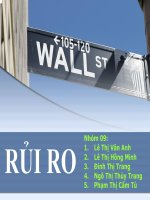Thuyết trình tài chinh doanh nghiệp The Global Financial Crisis and the Efficient Market Hypothesis What Have We Learned
Bạn đang xem bản rút gọn của tài liệu. Xem và tải ngay bản đầy đủ của tài liệu tại đây (1.83 MB, 65 trang )
“ Add your company slogan ”
Ray Ball, University of Chicago
Ray Ball, University of Chicago
The Global Financial
Crisis and the Efficient
Market Hypothesis:
What Have We Learned?
GVHD: GS. TS Trần Ngọc Thơ
Nhóm 5:
1.Nguyễn Đăng Khôi
2.Trịnh Thị Liên
3.Nguyễn Thị Hoài Linh
4.Nguyễn Thị Huyền Trang
TCDN1
Contents
What Does the EMH Say?
1
What Doesn’t the EMH Say?
2
Some Lessons from the Financial Crisis
3
Closing Thoughts
5
Anomalies, Behavioral Finance, and
the Future of “Market Efficiency”
4
TCDN
2
TCDN
Global financial crisis
Global financial crisis
3
The Efficient
Market Hypothesis
Free market
economics
Coordinated
political forces
do not improve
on the
“atomistic”
actions of
individuals—has
come under
concerted attack
The Blame
The Blame
Competitive
financial markets
ruthlessly exploit
all available
information when
setting security
price
TCDN
4
Jeremy
Grantham
EMH “responsible for the current financial crisis”
because of its role in the “chronic underestimation
of the dangers of asset bubbles” by financial
executives and regulators
Justin
Fox
Say much the same thing in his meticulously
researched, well-written, and best-selling history of
modern financial economics, The Myth of the
Rational Market
EMH
EMH
is
is
responsible
responsible
for the
for the
current
current
financial crisis
financial crisis
TCDN
5
The Turner Report by the
UK’s market regulator
reaches a similar
conclusion.
The reasoning boils down to this:
TCDN
Content
EMH
asset price bubble
The EMH—like all good
theories—has major
limitations
The claim that it is
responsible for the current
worldwide crisis seems
wildly exaggerated.
6
1720
Dutch tulip
“mania
•
Unusually large price run-ups.
•
Unusually large drops.
•
All of these occurred well before the advent
of the EMH and modern financial economic
theory.
The same
feature
1630
1840s
1926
1929
South Sea
Company
Bubble
The
Railway
Mania
Florida
Land
Bubble
Events
surrounding
the market
collapse
1965
1
TCDN
7
TCDN
EMH
EMH
Eugene Francis "Gene" Fama
(Born February 14, 1939)
American economist,
Professor of Finance at the
University of Chicago Booth Scho
ol of Business
In 2013, Nobel Memorial Prize in
Economic Sciences with Robert
Shiller and Lars Peter Hansen.
The prices reflect
all available
information in the
market. So no-one
can earn excess
returns.
There are three
major versions of
the hypothesis:
"weak", "semi-
strong", and
"strong".
Fama is most
often thought of
as the father of
the efficient-
market
hypothesis,
beginning with his
Ph.D. thesis.
In January 1965,
Eugene Fama
published his
dissertation
arguing for the
random walk
hypothesis
WHO
WHAT
WHEN
8
Các dạng EMH
TCDN
Các phân tích kỹ thuật không mang lại lợi nhuận
cao hơn mức trung bình chung của toàn thị trường.
9
2
The argument: because of EMH, people (price-
taker) viewed current prices as correct and so
failed to verify true asset values (EMH bubbles).
BUT: Money flows into mutual funds strongly
follow past performance, as if individual managers
consistently beat the market over time, and despite
the evidence that the past performance of most
money managers is a poor predictor of future
performance.
TCDN
10
Much of the enormous losses by banks and
investment banks in 2007-2008 originated in their
trading desks and proprietary portfolios, whose
strategies and very existence were premised on
making money from market mispricing.
Investors who poured money into the property
market, stock market, and other asset markets in
the years while the bubbles were forming cause
they believed prices would continue to rise
they believed current prices were incorrect
TCDN
11
It seems inconsistent to argue simultaneously that
asset price “bubbles” occur and that investors
passively believe current asset prices are correct.
If more homeowners, speculators, investors, and
banks had indeed viewed current asset prices as
correct, they might not have bid them up to the
same extent they did, and the current crisis might
have been averted.
TCDN
12
3
When asset prices are rising rapidly their level, it is
not subject to scrutiny by investors seems wildly
at variance with the facts.
Fed Chairman Alan Greenspan’s 1996 use of the
words “irrational exuberance” (Visited October 18,
2009, with google search of “Alan Greenspan
irrational exuberance speech” yielded over six
million hits.
TCDN
13
The reason for the losses
TCDN
EMH
=
14
What the crisis tells us about the efficient markets
theory?
Does the rapid and substantial fall in prices that
occurred across countries and asset classes invalidate
the notion of market “efficiency”?
Does it merely serve to remind us of its considerable
limitations as a theory to help us understand the
behavior of asset prices?
If so, then what are those limitations?
TCDN
15
1. What Does the EMH Say?
1. What Does the EMH Say?
TCDN
16
Public information is costless to obtain, and
hence the gains from its use should be competed
away to zero.
Cannot expect to earn above-normal returns from
using publicly available information because it
already is reflected in prices.
TCDN
17
What Doesn’t the EMH Say?
What Doesn’t the EMH Say?
The EMH has been the subject of so much
misunderstanding that outlining some of the things
the hypothesis does not say occupies considerably
more space than what it does say.
TCDN
18
1. No one should act on information.
TCDN
EMH does not say all investors should stop acting
on information.
As a consequence, security prices were allowed
to deviate substantially from their true values. The
critique confuses a statement about an equilibrium
“after the dust settles” and the actions required to
obtain that equilibrium.
19
2. The market should have predicted the crisis.
The EMH does not imply that one can—or should
be able to—predict the future course of stock
prices generally, and crises in particular.
Exactly the opposite: if anything, the hypothesis
predicts we should not be able to predict crises. If
we could predict a market crash, current market
prices would be inefficient because they would not
reflect the information embodied in the prediction.
Under the EMH, then, one can predict that large
market changes will occur, but one can’t predict
when
TCDN
20
3. The stock market should have known we were in an asset “bubble.”
The speech was given on December 5, 1996,
a day on which the Dow Jones closed at
6437. If that statement is taken to mean that
prices were too high at the time, the clear
implication is that by today—when we all
know how inefficient the market is and how
irrationally exuberant we were 13 years ago.
And after 13 years to reflect on Greenspan’s
warning, investors are not acting as if there
was a bubble when he sounded the warning.
I—a financial economist skeptical about the
possibility of identifying asset bubbles
except in hindsight—seem to have been
more wary of a bubble than the people who
blame “the market” (but not themselves) for
creating it.
TCDN
Irrational
exuberance
21
Alan Greenspan
4. The collapse of large financial institutions indicates the market is inefficient.
If you take massive risky positions financed with
extraordinary leverage, you are bound to lose big
one day—no matter how large and venerable you
are. Market efficiency does not predict there will be
no spectacular failures of large banks or investment
banks.
=>If anything, it predicts the opposite—that size
and venerability alone will not guarantee you
positive abnormal returns, and will not protect
you from the forces of competition.
TCDN
22
5. The EMH assumes that return distributions do not change over time.
The EMH is completely silent about the shapes of
the distributions of securities’ returns.
What the EMH does say about return distributions is
that, given a certain amount and kind of publicly
available information, security prices are “efficient” in the
statistical sense that they are “minimum-variance”
forecasts of future prices.
TCDN
23
In the Turner Review, a post mortem report issued by the U.K.’s
market regulator at the request of the Chancellor of the
Exchequer
Market prices are good indicators of rationally evaluated
economic value => Only this propositions bears any
resemblance to the simple notion of efficient price responses to
information.
The risk characteristics of financial markets can be inferred
from mathematical analysis, delivering robust quantitative
measures of trading risk => market efficiency implies there are
“robust quantitative measures of trading risk”—involves a
considerable exaggeration of the theory’s prescriptive import.
TCDN
24
6. Financial regulators mistakenly relied on the EMH.
If regulators had been true believers in efficiency, they
would have been considerably more skeptical about
some of the consistently high returns being reported by
various financial institutions. If the capital market is
fiercely competitive, there is a good chance that high
returns are attributable to high leverage, high risk, inside
information, or dishonest accounting.
And they would have been exceptionally skeptical of the
surreally high and stable returns reported over an
extended period by Bernie Madoff.
TCDN
25









